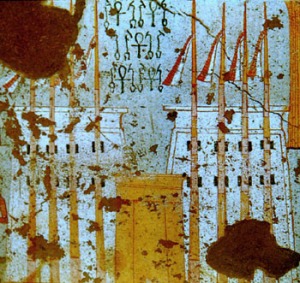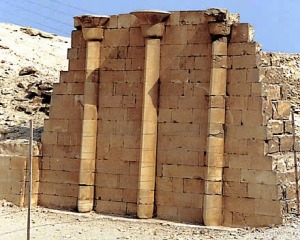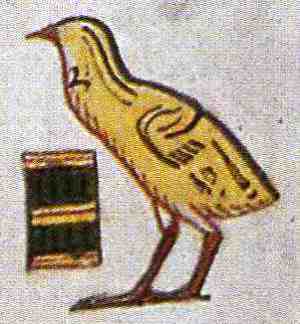Number thirteen! Are you feeling lucky or unlucky? I’m feeling quite lucky that although this week’s post concerns two words, the words consist of only one hieroglyph each:

Netjer aa, the great god. What excellent value per hieroglyph.
As with many languages, the adjective follows the noun in Egyptian, so the first word, netjer, is the word for god. I bet, after finding out that they spelled the word for king with a stick of salad and a bread roll, you can’t wait to find out what they used to convey the idea of divinity. I bet if I told you it was one of those little paper labels you stick in cheese, you’d at least half believe me.
Actually, it’s not a million miles away from that; it is a flag. Just as fetish symbols were erected at Egyptian shrines from the Predynastic period onwards, so banners with emblems of the gods were set up on flagpoles outside their temples. The flagpoles are gone now, but you can still see the sockets that housed them when you visit temples in Egypt today. This is Luxor temple, where there are four deep sockets in the facade of the first pylon where the massive poles were once lodged.

And this is what they would once have looked like:

This is probably about as much as the average Egyptian got to see of the local god much of the time. Most of them would not have been allowed very far beyond the front gate of the temple, except on very special occasions. Even when the god’s statue was carried in procession, it was hidden from sight in a curtained shrine. So the flags really came to stand for the gods in people’s minds, to the extent that it was the simplest way of writing the word for god:

And it’s not difficult to draw. Just draw a flag on a pole.
![]()
![]()
Aa, great, is slightly more tricky. It’s a wooden column, of the sort used in houses or smaller or buildings, where it wouldn’t have had to support a great deal of weight. I suppose using a pillar to convey greatness kind of figures. Wooden columns are mainly known from paintings and models, as they’ve mostly perished. One good source for what they looked like, though, is the step pyramid complex of Djoser at Saqqara, as they were only just learning to work in large quantities of stone then, and the buildings imitate wooden originals. These are stone imitations of wooden columns at Saqqara:

You can see from this painted version of the hieroglyph that the column symbol is broader towards the base and more slender towards the top. ![]()
It seems to have a capital shaped like a papyrus umbel, like the Djoser columns, with an abacus – the cover plate that connects the column with the ceiling – on the top, like this one:

So, when you’re drawing it, you need to convey the intricacies of the capital. I usually draw two back-to-back little scollops to start with ![]() then an equal and opposite pair underneath
then an equal and opposite pair underneath
![]()
then the slightly pear-shaped body of the column:
![]()
But you’ll figure out what works best for you. Luck has nothing to do with it. It’s all about practice.









